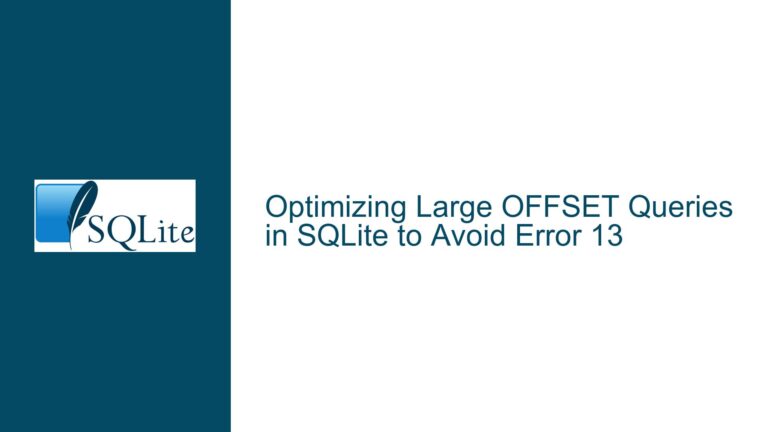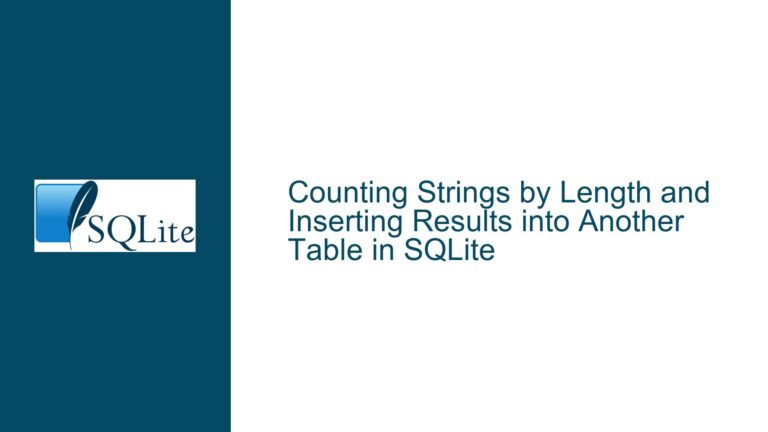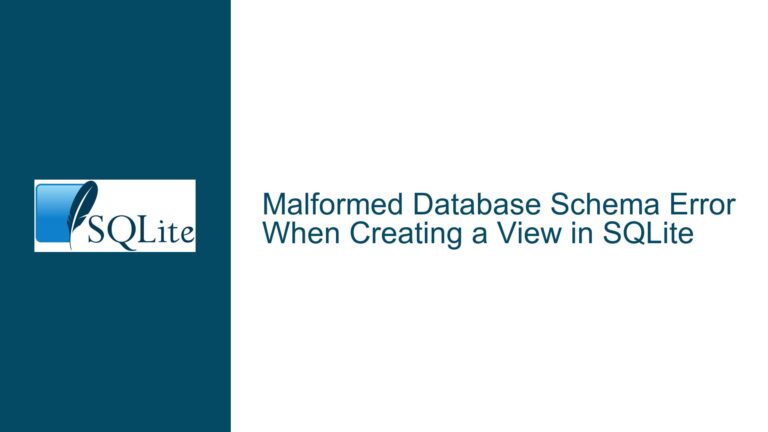Overflow Issue in SQLite’s `ROUND(X,Y)` Function with Large `Y` Values
Understanding the Overflow Behavior in ROUND(X,Y) Function
The ROUND(X,Y) function in SQLite is designed to round a floating-point value X to Y digits to the right of the decimal point. When Y is negative or omitted, it defaults to 0, meaning no decimal places. However, a critical issue arises when Y is assigned extremely large values, particularly those exceeding the 32-bit signed integer range. This results in an overflow condition, where the function behaves unpredictably due to the truncation of Y to its lower 32 bits. For example, when Y is set to 2147483648 (which is 0x80000000 in hexadecimal), it is interpreted as -2147483648 due to integer overflow, causing the function to round incorrectly. This behavior is inconsistent with the expected functionality, where ROUND(X,Y) should handle large Y values gracefully or explicitly reject them with an error.
The overflow occurs because SQLite internally treats Y as a 32-bit signed integer. When Y exceeds the maximum value for a 32-bit signed integer (2147483647), it wraps around into negative territory, leading to incorrect rounding results. For instance, ROUND(123.456, 2147483648) incorrectly returns 123.0 instead of 123.456, as the function interprets Y as -2147483648 and rounds to 0 decimal places. This issue persists for values beyond 4294967296 (the 32-bit unsigned integer limit), where the function cycles through the same truncated range, causing further inconsistencies.
Causes of Integer Overflow in ROUND(X,Y) Function
The root cause of this issue lies in SQLite’s internal handling of the Y parameter in the ROUND(X,Y) function. SQLite uses a 32-bit signed integer representation for Y, which limits its range to -2147483648 to 2147483647. When Y exceeds this range, it overflows and wraps around, leading to unexpected behavior. For example, a Y value of 2147483648 (which is 0x80000000 in hexadecimal) is interpreted as -2147483648 due to the overflow, causing the function to round incorrectly.
This behavior is exacerbated by the lack of explicit range checking for Y in the ROUND(X,Y) function. SQLite does not validate whether Y falls within the supported range before performing the rounding operation. As a result, values outside the 32-bit signed integer range are silently truncated, leading to incorrect results. For instance, ROUND(123.456, 4294967296) incorrectly returns 123.0 instead of 123.456, as the function interprets Y as 0 due to truncation.
Another contributing factor is the absence of documentation specifying the supported range for Y. While the SQLite documentation describes the behavior of ROUND(X,Y) for valid inputs, it does not explicitly state the limitations for large Y values. This lack of clarity can lead to confusion and unexpected behavior when users attempt to use the function with large values of Y.
Resolving the Overflow Issue in ROUND(X,Y) Function
To address the overflow issue in the ROUND(X,Y) function, several steps can be taken to ensure correct behavior and prevent unexpected results. The first step is to update SQLite to handle large Y values correctly by using a 64-bit integer representation for Y. This would extend the supported range for Y and eliminate the overflow issue. For example, a Y value of 2147483648 would no longer be interpreted as -2147483648, and the function would round correctly to the specified number of decimal places.
If extending the range of Y is not feasible, SQLite should implement explicit range checking for Y in the ROUND(X,Y) function. This would involve validating whether Y falls within the supported range before performing the rounding operation. If Y exceeds the range, the function should return an error or a warning, indicating that the input is out of bounds. For example, ROUND(123.456, 4294967296) would return an error message such as "Y value out of range" instead of truncating Y and producing incorrect results.
Additionally, the SQLite documentation should be updated to specify the supported range for Y in the ROUND(X,Y) function. This would provide users with clear guidance on the limitations of the function and help prevent misuse. The documentation should also include examples of how the function behaves with large Y values and explain the potential for overflow if the range is exceeded.
For users encountering this issue in SQLite version 3.48.0, the recommended solution is to upgrade to a newer version of SQLite that includes the fix for this bug. The fix, implemented in commit a9759fc78d6cb0df, addresses the overflow issue by correctly handling large Y values in the ROUND(X,Y) function. Upgrading to the latest version of SQLite will ensure that the function behaves as expected and avoids the overflow problem.
In cases where upgrading SQLite is not immediately possible, users can implement a workaround by validating Y values before passing them to the ROUND(X,Y) function. This can be done using a custom function or script that checks whether Y falls within the supported range and adjusts it if necessary. For example, if Y exceeds 2147483647, the script could set it to 2147483647 to avoid overflow. While this workaround is not ideal, it can help mitigate the issue until a permanent fix is applied.
In conclusion, the overflow issue in SQLite’s ROUND(X,Y) function is caused by the use of a 32-bit signed integer representation for Y, which leads to incorrect behavior when Y exceeds the supported range. To resolve this issue, SQLite should either extend the range of Y using a 64-bit integer representation or implement explicit range checking to prevent overflow. Users should upgrade to the latest version of SQLite to benefit from the fix and avoid encountering this issue in their applications.






